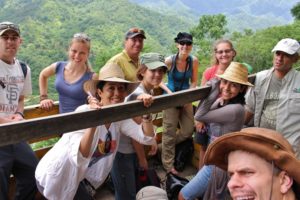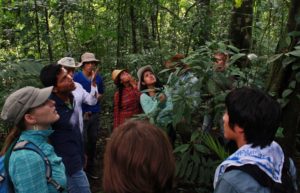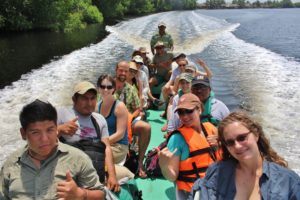
CTLT students visiting different watersheds in Biosphere Reserves in the Sierra Madre Mountains – the source of 40% of the fresh water in the country
Twenty students from Colorado State University’s Warner College of Natural Resources recently finished their study abroad semester in Chiapas in Southeast Mexico. The students are the second cohort of CSU’s Conservation Leadership Through Learning (CLTL) master’s program, which combines one year of on-campus curriculum with one semester immersed in conservation issues abroad.
During their time in Chiapas, the students participated in bilingual Spanish classes focused on conservation and sustainable development issues in Mexico. The international classes were offered through ECOSUR University, which partners with CLTL. With the partnerships, students earn a dual degree: one from CSU and one from ECOSUR.
During their semester abroad, students worked in five theses groups in collaboration with local nonprofit and government organizations as well as local communities. The Mexican-based partners help determine the most pressing issues facing the region to which students can make a meaningful contribution.
This year the thesis projects focused on the following topics:

CLTL students visited Lacandona Jungle – the largest protected area in Chiapas. Indigenous groups and wide variety of wildlife live and share this ecosystem.
1. Assessing national and international climate change policies and strategies in Chiapas.
2. Monitoring and evaluating water fund programs utilizing ecosystem service systems.
3. Developing a wildlife conservation and game management plan in the Calakmul Biosphere Reserve.
The students spent three months in the field collecting ecological and social data. As part of their collaboration with local stakeholders and to fulfill their academic program requirements, the students will create tools and resources to help facilitate the application of their research by local communities and organizations. These tools will include videos, informational posters, brochures, research summaries, and more to help deliver their thesis in a way that has the most immediate benefit and impact for the community.

CLTL students visit the tallest mangroves in Latin America with trees up to 100 feet tall. The cohort visited local fisheries and communities that are challenged by pollution and sediment deposition in their water source.
Students will defend their thesis in February and March from both ECOSUR and CSU campuses.
The third cohort of CLTL students is preparing to travel to Kenya, Peru and New Zealand in June 2014 to conduct similar studies with local partners.
For more information about the program, visit http://warnercnr.colostate.edu/cltl-how-to-apply and on Facebook.
Posted Jan. 31, 2014 by Bryony Wardell

